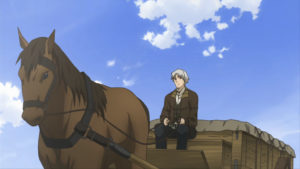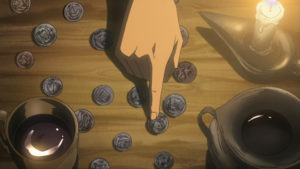In Short:
Spice and Wolf is a 2 season, 24 episode anime from 2008 that is adapted from a long running series of light novels and manga. It tells the story of traveling merchant Kraft Lawrence and his companion Holo, a haughty yet clever wolf goddess who travels along side him in human form. In addition to bushels of downright excellent banter between its two leads, Spice and Wolf puts medieval economics front and center throughout its four main story arcs in a way that, astonishingly, remains interesting and tension filled right to the very end.
Though Spice and Wolf’s art is never bad, it is fairly modest compared to most shows I recommend. Come for the great leads and interesting economics, not flashy scenes or outstanding effects. This is also an anime that, unfortunately, ends on a somewhat of a lesser arc and an abrupt cliffhanger. On the bright side, the light novel series and manga have long since been complete and are readily available in both Japanese and English, so the story can continue if you wish it to.
Suggested Watch Minimum: 2 episodes. One of Spice and Wolf’s most notable aspects, its banter between its two lead characters, doesn’t really begin in earnest until its second episode. I also think Lawrence and Holo’s conversation about wolves is worth seeing before you make a decision.
Full Review:
 Spice and Wolf centers chiefly around Kraft Lawrence, an adult merchant in his prime who travels from town to town buying and selling a variety of wares in order to earn a living. Lawrence is an excellent business man and has a keen sense for making profitable deals, but he is also kind and personable, which tends to earn him the favor of most people he does business with.
Spice and Wolf centers chiefly around Kraft Lawrence, an adult merchant in his prime who travels from town to town buying and selling a variety of wares in order to earn a living. Lawrence is an excellent business man and has a keen sense for making profitable deals, but he is also kind and personable, which tends to earn him the favor of most people he does business with.
At the beginning of the series, Lawrence stops to trade with the wheat producing town of Pasloe just as it is finishing its harvest. He gets to watch as they carry out one of their harvest traditions where the person who cuts the last stalk of wheat puts on a mask and pretends to be the ancient wolf goddess Holo. This goddess was said to have made a deal with the town many generations ago whereby she would grant them bountiful harvests in exchange for their patronage. In more recent times, modern farming tools and techniques have largely seen Holo forgotten, though the town still performs a few last traditions in her honor.
 Lawrence feels an odd bump from the rear of his cart just as those last stalks of wheat are cut, but he quickly forgets about it as he interacts with the friendly residents. That night, however, on the road from Pasloe to the next town, Lawrence discovers what appears to be a young teenage girl sleeping naked in the back of his covered cart. When he wakes her he finds that she has the ears and furry tail of a wolf! This girl claims that she, in fact, is Holo the Wise Wolf and upon Lawrence’s insistence, she is able to prove it in dramatic and terrifying fashion!
Lawrence feels an odd bump from the rear of his cart just as those last stalks of wheat are cut, but he quickly forgets about it as he interacts with the friendly residents. That night, however, on the road from Pasloe to the next town, Lawrence discovers what appears to be a young teenage girl sleeping naked in the back of his covered cart. When he wakes her he finds that she has the ears and furry tail of a wolf! This girl claims that she, in fact, is Holo the Wise Wolf and upon Lawrence’s insistence, she is able to prove it in dramatic and terrifying fashion!
With the villagers no longer really upholding their end of their promise, Holo has decided it is time for her to move on from the town. She request that Lawrence allow her to travel with him as she makes her way back to her home in the north. What follows is the adventures of these two as they become traveling companions, business partners, friends, and perhaps something more.
 The relationship and banter between Lawrence and Holo is one of Spice and Wolf’s two main draws. While Lawrence is very adept at trade, he is a fairly straight-laced individual and often finds himself teased by the sometimes haughty, sometimes playful Holo. At the same time, Holo, who is some several hundred years old despite her youthful appearance, finds she has a lot to learn from the peddler she has decided to travel with.
The relationship and banter between Lawrence and Holo is one of Spice and Wolf’s two main draws. While Lawrence is very adept at trade, he is a fairly straight-laced individual and often finds himself teased by the sometimes haughty, sometimes playful Holo. At the same time, Holo, who is some several hundred years old despite her youthful appearance, finds she has a lot to learn from the peddler she has decided to travel with.
The range of topics and emotions the two engage each other with is fairly extensive, but more than that, it’s just so well done. They easily slip between discussing the practicalities of their plans in the next town, to goading each other with clever wordplay, to, at times, being put out or even hurt by one another in unexpected ways. It’s a little hard to describe, but despite one of the two being an immortal wolf goddess with a high opinion of herself, their conversations always have a feeling of reality and subtly to them that you don’t often get in even the best anime.
 It actually took me a good two or three episodes to really understand Holo’s frequent teasing of Lawrence, but what’s great about it is that the same holds true for Lawrence within the show. At first, he is often cut short by Holo’s proud nature and the little verbal traps she playfully lays out for him, but as time goes on, he begins to learn what flatters her, what angers her, and, perhaps most importantly, how best to tease her back.
It actually took me a good two or three episodes to really understand Holo’s frequent teasing of Lawrence, but what’s great about it is that the same holds true for Lawrence within the show. At first, he is often cut short by Holo’s proud nature and the little verbal traps she playfully lays out for him, but as time goes on, he begins to learn what flatters her, what angers her, and, perhaps most importantly, how best to tease her back.
And for Holo’s part, she never claims any real amount of power or authority as a goddess, in her words she simply is who she is, and she and Lawrence are mostly equals in their relationship, but, over time, she learns to put her faith in Lawrence’s business sense and supports him as best she can. There’s also a slowly developing romantic tension between Holo and Lawrence that eventually sees them on largely the same page by the end of the series.
 This progression between the two of them, from having a simple business arrangement to wanting to travel together above even their most deeply held dreams, plays out over the course of the show and just adds further to what makes them top tier characters.
This progression between the two of them, from having a simple business arrangement to wanting to travel together above even their most deeply held dreams, plays out over the course of the show and just adds further to what makes them top tier characters.
As the show progresses, we follow Lawrence and Holo through four main story arcs. Each one places a different challenge before the pair that test both their business sense and their growing feelings for each other. A lot of the time, the two have to work together to keep Holo’s true identity a secret. If the ever present church were to find out she is a pagan goddess, they would likely try to exorcise her or kill her in the name of the one true god. Holo poses as everything from Lawrence’s quiet business partner to his badly burned young wife so she can keep her wolf ears and tail hidden beneath her cloak. While keeping Holo’s identity a secret doesn’t play as large a role as the focus on finance and trade, it does come up from time to time in some interesting ways.
 Spice and Wolf’s other core draw is its fascinating dedication to exploring medieval business and trade. Lawrence travels constantly from town to town trading one type of good, say furs, for another, such as apples. Though he almost always treats his clients with graciousness and respect, Lawrence does look to make the largest honest profit he can so as to one day fulfill a far off dream.
Spice and Wolf’s other core draw is its fascinating dedication to exploring medieval business and trade. Lawrence travels constantly from town to town trading one type of good, say furs, for another, such as apples. Though he almost always treats his clients with graciousness and respect, Lawrence does look to make the largest honest profit he can so as to one day fulfill a far off dream.
But now, with Holo at his side, Lawrence finds he has a business partner who is clever, thanks to her incredibly long life and innate resourcefulness, but who, because she had only dwelt near Pasloe for many generations, is also somewhat naive to realities of business dealings in the modern medieval world. This gives Lawrence the chance to explain things like the different worths of various silver coins and the reasons behind those differing values, or, how traveling merchants group together in guilds to protect and enhance each other’s good name. Though Holo may not understand a concept at first, she is often wise enough and quick-witted enough to catch on quickly. And, as she learns and explains new concepts to herself, we get to learn right along with her.
That I often think back to this anime when I hear about the real world valuations of currency, or import tariffs, or short selling stock, or trade negotiations is a credit to just how well Spice and Wolf handles the economic sides of its stories.
Graphics & Sound:
 As noted above, Spice and Wolf’s art and animation are, perhaps, the least of its draws. It has great backgrounds, great character designs, and doesn’t cheap out anywhere in particular. There’s just something with the direction in general and action scenes in particular that lack the fluidity and movement you might see in other anime. Still, the show does have good direction in general and some great shots of its cities that do a good job showing off their layout and scale.
As noted above, Spice and Wolf’s art and animation are, perhaps, the least of its draws. It has great backgrounds, great character designs, and doesn’t cheap out anywhere in particular. There’s just something with the direction in general and action scenes in particular that lack the fluidity and movement you might see in other anime. Still, the show does have good direction in general and some great shots of its cities that do a good job showing off their layout and scale.
As for sound and music, I have no complaints. The opening songs of each season are wonderful. They both have this sort of sad comfort and coziness which is very appealing. Its two closings are a good bit more playful which works great most times, though I think there might be a couple of instance where we cut from heavy tension to happy, upbeat engrish. While a bit jarring, it’s certainly not the worst offender I’ve ever seen, so I’ll give it a pass for its rare minor musical sins.
 Finally, it takes good voice actors to pull off the wide ranging exchanges we get from Lawrence and Holo. Holo, in particular, can switch from feisty, to drunk, to introspective, to lonely, to appreciative all within the span of a single scene, and both her Japanese and English voice actresses pull off her various moods with aplomb! If you’re looking for a killer, best of anime performance, stick around until season 2 episode 3 where Japanese actress Ami Koshimizu kills it as Holo.
Finally, it takes good voice actors to pull off the wide ranging exchanges we get from Lawrence and Holo. Holo, in particular, can switch from feisty, to drunk, to introspective, to lonely, to appreciative all within the span of a single scene, and both her Japanese and English voice actresses pull off her various moods with aplomb! If you’re looking for a killer, best of anime performance, stick around until season 2 episode 3 where Japanese actress Ami Koshimizu kills it as Holo.
Lawrence is more subdued, most times, but he too goes through his fair share of emotions. If anything, we know that J. Michael Tatum, Lawrence’s English voice actor, has far and away more than enough range to pull off Lawrence thanks to his energetic, best of the best performance as Okabe Rintaro in Steins;Gate. Lawrence’s Japanese voice actor is pretty well regarded, as well, having started in a decent number of high profile roles. So, no matter how you watch it, Spice and Wolf is just a delight to listen to.
All In All:
Spice and Wolf somehow manages to combine great characters and conversations with explorations of medieval trade in a way that’s actually interesting and engaging. The relationship between Lawrence and Holo is very well regarded by anime veterans for good reason, and you don’t have to try hard at all to find someone who will jokingly claim that this anime helped them get through their economics classes.
 There are many, many good interactions between Lawrence and Holo throughout the series, but one of my favorite early ones is the conversation about wolves I mentioned at the first of this review. We get to see how Holo enjoys teasing Lawrence. She spins a little, playful folk tale about her kind not realizing that to Lawrence, a wolf attack is a deadly serious thing. We even see that Lawrence has lost traveling companions to wolves. That he’s seen them torn apart by them!
There are many, many good interactions between Lawrence and Holo throughout the series, but one of my favorite early ones is the conversation about wolves I mentioned at the first of this review. We get to see how Holo enjoys teasing Lawrence. She spins a little, playful folk tale about her kind not realizing that to Lawrence, a wolf attack is a deadly serious thing. We even see that Lawrence has lost traveling companions to wolves. That he’s seen them torn apart by them!
When Holo realizes what she’s done, she and Lawrence abruptly pause their banter for the entire time it takes them to pass through a village. For two companions that chat almost constantly, this long moment of tense silence is very powerful. When they emerge back into the countryside, Holo does the right thing and apologizes. It’s one of the first times that we see Holo as something more than a haughty, teasing goddess, and get to view her as a real person who can make mistakes.
 Though Holo is typically quite feisty, pay attention to the times when she isn’t. Her sense of loneliness, isolation, and the way she worries about her future even though she is effectively immortal are some of the things that elevate her to being one of my favorite characters in all of anime.
Though Holo is typically quite feisty, pay attention to the times when she isn’t. Her sense of loneliness, isolation, and the way she worries about her future even though she is effectively immortal are some of the things that elevate her to being one of my favorite characters in all of anime.
I’ll leave it to you, dear reader, to evaluate Lawrence and Holo’s relationship further. But, before I go, I’ll leave you with an interesting recommendation for another anime. If it turns out you liked the economics lessons of Spice and Wolf, go give Maoyu a try. It’s certainly the lesser of these two shows, but it was made by some of the same people and has a very familiar art style and aesthetic. Though not connected plot or character wise, the show relates to Spice in Wolf in the way it shows how a small medieval village is able to grow into a thriving city through the use of improved tools and techniques. You get explanations of things like crop rotations and trade deals and so on in much the same way Lawrence explains currency valuation to Holo.
Maoyu’s underlying plot and attempted romance between its leads never engages as well as anything in Spice and Wolf, but it’s still worth a watch for its economics lessons alone.